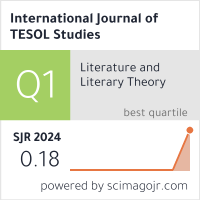2632-6779 (Print)
2633-6898 (Online)


Scopus
Ulrich’s Periodicals Directory (ProQuest)
MLA International Bibliography
MLA Directory of Periodicals
Directory of Open Access Journals (DOAJ)
QOAM (Quality Open Access Market)
British National Bibliography
WAC Clearinghouse Journal Listings
EBSCO Education
ICI Journals Master List
ERIH PLUS
CNKI Scholar
Gale-Cengage
WorldCat
Crossref
Baidu Scholar
British Library
J-Gate
ROAD
BASE
Publons
Google Scholar
Semantic Scholar
ORE Directory
TIRF
China National Center for Philosophy and Social Sciences Documentation
Ana Elina Martinez-Insua
Universidade de Vigo, Spain
Abstract
This study explores Theme and its presence in English L1 and L2 writing. Adopting the Hallidayan definition as a point of departure, Theme is characterised by its position and its orienting function. Drawing on Berry’s (2013) distinction between contentful and contentlight Subject Themes and Prince’s (1981) scale of assumed familiarity, the study works on a scale of contentfulness to classify thematic components according to semantic weight. The research aims to test the appli(c)ability of Theme and contentfulness in the process of teaching and learning English and assumes that greater awareness of the thematic structure of native English may benefit learners and teachers alike. The learner data are drawn from the Written Corpus of Learner English (WriCLE), and the English L1 control sample from the Louvain Corpus of Native English Essays (LOCNESS). The findings reveal the presence of significant differences between Themes produced by L1 and L2 writers, as well as significant connections between the L1-user/L2-user dichotomy and certain features of the thematic components in the essays analysed. The findings support the importance of introducing not only
corpus literacy, but also notions such as Theme and contentfulness into the process of teaching and learning English L2.
Keywords
Subject Theme, contentfulness, learner English